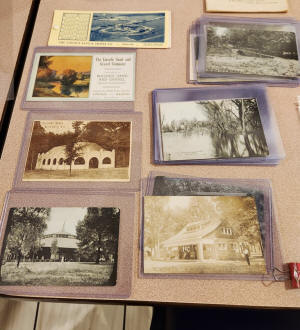|
Brenda Short shares history of
Lincoln Lakes at Logan County Genealogical & Historical Society
annual dinner
 Send a link to a friend
Send a link to a friend
[November 30, 2022]
Monday, November 21, the Logan County Genealogical
and Historical Society held its annual dinner meeting at Daphne’s
Restaurant.

After dinner, Brenda Short provided a presentation on the history of
Lincoln Lakes. She also shared some history of the Lincoln
Chautauqua property and Lincoln Sand and Gravel because their
histories intertwine with Lincoln Lakes.

A lifelong resident of Lincoln, Short has owned property at Lincoln
Lakes since 2001 and recently moved there permanently. As a local
realtor for the past 27 years, Short is interested in old houses and
collects Lincoln, Illinois memorabilia.
Chautauqua

Short handed out a timeline of important dates in the history of
Chautauqua commons, Lincoln Sand and Gravel and Lincoln Lakes. Some
records for Lincoln Sand and Gravel and the Chautauqua Commons can
be found at the Logan County Genealogical and Historical Society.
The 120-acre Lincoln Chautauqua property was leased from Ella
Brainard in 1901. An auditorium at Lincoln Chautauqua was completed
in 1904 and many events were held there. Lincoln Chautauqua would
get electricity in 1905 and water by 1907.
The Chautauqua grounds were sold to the Elks in 1942. In 1960, the
grounds were sold to the City of Lincoln from the Elks. It then
became Memorial Park.
Lincoln Sand and Gravel
In 1905, 278 acres were purchased by engineer Wyndham C. Jones near
the Salt Creek Bottoms. When a train was going over the trestle,
Short noted that there were areas that were giving way. Upon further
investigation, it was discovered there was quite of bit of sand in
the area.
It was in this area Jones formed Lincoln Sand and Gravel, which had
40 employees at one point. He and others saw there would soon be a
need for materials because all the highways were going to be
concrete. Short said Lincoln Sand and Gravel would be part of that
transition for the state.

A Road Improvement Bill passed in 1918 with voters approving a
$60-million bond for paving the roads.
Route 66 was created in 1926. By 1930, Illinois was the first state
to complete the paving of the now historic “Mother Road.”
Lincoln Lakes
In 1929, V.O. Johnston, president of Lincoln Sand and Gravel,
announced plans for a recreational center at Lincoln Lakes. By
August of that year, a sandy beach and temporary dressing rooms were
built. Learn to swim week was underway, and approximately 3,000
people participated in the classes that summer.

The permanent beach was open in 1931 with a
bathhouse, concession stands, lifeguard stands and lighting. A
season pass was $2.50.

Short’s collection of memorabilia from Lincoln Lakes includes
photos, newspaper clippings and other mementos. Larry Shroyer has
given Short several advertisements for events there.
[to top of second column] |


Short said these ads show how the swimsuit styles changed over
the years.
In 1934, Herbert Beach leased a one-acre lot from Lincoln Sand
and Gravel so he could move a cottage from the Chautauqua
grounds. This cottage, the National Bank Bungalow, was the first
privately owned cottage at Lincoln Lakes. The Shorts later
bought this house, and they have a lot of information on its
history.
By 1937, many cottages from Chautauqua were moved to Lincoln
Lakes. Many of the homes out at Lincoln Lakes were just summer
homes and Short said most did not have good foundations under
them. The Shorts unfortunately had to tear the original house
down.
Fifty-year leases were attached to the land where the houses
were located. By 1978, members knew the leases would be coming
due. Paperwork was then started for purchasing the Lincoln Lakes
area along with all the lots.
Gene Burwell, Perry Luckhart, Frank Yunker and Betty Thompson
were on the steering committee to create a homeowner’s
association.

Creating the homeowner’s association took four years because
they had to get everyone to agree and had to give them a price.
Ron Fox and Joe Reichle did surveys on each lot. There were
corporation papers to fill out and attorneys who had to be
involved in setting everything up.
The owners at the time were asking for $400,000 for the land.
The group offered $360,000, but Short said they were turned
down. Short said about 300 acres were sold for $375,000.
Approximately 200 acres are a shared or “commons” area. The lake
surface is 100 acres.
The Lincoln Lakes Condo Association was established by 1983. At
the time, Short said there were approximately 40 houses there.
With the condo association, the lake became a “members only,”
restricted area, and non-member boats and sheds had to be
removed.
One person asked how water stays in the lake.
Short said the lake is spring fed. She said water levels are low
right now. After spring rains, Short said water levels get
higher.
Unfortunately, floods have brought in Asian Carp and other dirty
fish from Salt Creek. At one point, 16,000 pounds of these fish
were caught. Fortunately, the Clinton Power Plant has helped
curtail the flooding. The last big flood at Lincoln Lakes was in
1995.
Events at Lincoln Lakes
Events over the years have included water carnivals. Short said
the carnivals include diving contests and several people on
boats dressed up like clowns and doing crazy things.
The first water carnival was held at Lincoln Lakes July 3, 1932,
with approximately 1,500 people attending.
At the 1959 water carnival, Short said close to 5,000 people
attended.
The American Red Cross gave between 400 and 500 lessons a year
at Lincoln Lakes for many years.
When the Lincoln Park District public pool opened in 1967,
membership at the Lincoln Lakes dropped significantly. Swimming
also declined at Lincoln Lakes Beach after someone drowned there
July 5, 1975.
One map Short has shown train tracks and spurs. The train was
used for transporting sand and gravel once it was mined. The
interurban would bring people out to Lincoln Lakes.
The foundation of one of the buildings is still in front of
Short’s house.
In recent years, the Polar Plunge, which helps raise funds for
the Special Olympics, was held at Lincoln Lakes.
Memories of Lincoln Lakes
One member had a Rotary exchange student from Japan staying with
her family. She said the student wrote in Japanese in the sand
at the and remembers her really enjoying the visit.
LCGHS member Bill Donath remembers working as a basket boy at
Lincoln Lakes in the 1960s. When people changed into their
swimsuits, they put their clothing in the baskets.

To sanitize the water, Donath recalls chlorine tablets being
thrown in the lake.
On many advertisements, Short said they said it was a sanitary
beach.
The dive tower is something many who swam at Lincoln Lakes would
remember. Short said the sign from the dive tower that listed
all the rules hanging in the hallway of her home.
Short’s presentation stirred up memories of fun times for many
people.
[Angela Reiners] |